![]() There is one question which comes back rather often in the Yoctopuce team. Here it is: How to make Yoctopuce modules work in the middle of nowhere, in the back of the garden, for instance?. Indeed, it is unlikely to have an electrical outlet in the back of the garden, without even talking about a USB connection. In the opposite, there is sunshine, and we can easily make sure that we also are within a Wifi range. We are not solar specialists, but Yoctopuce modules consuming an average of 125 mW, it shouldn't be all that difficult to make them work with a solar panel...
There is one question which comes back rather often in the Yoctopuce team. Here it is: How to make Yoctopuce modules work in the middle of nowhere, in the back of the garden, for instance?. Indeed, it is unlikely to have an electrical outlet in the back of the garden, without even talking about a USB connection. In the opposite, there is sunshine, and we can easily make sure that we also are within a Wifi range. We are not solar specialists, but Yoctopuce modules consuming an average of 125 mW, it shouldn't be all that difficult to make them work with a solar panel...
We have therefore decided to make an experiment designed to determine the size of the various components necessary to make Yoctopuce modules work with solar energy. This experiment has the shape of a case containing Yoctopuce modules and which must be able to function 24/7, if possible.
Power supply components
To make an appliance work with solar energy, we cannot simply connect it to a solar panel, we need a number of components. We need:

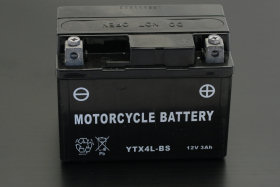
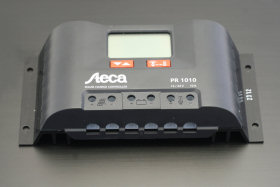
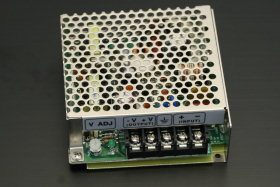
The power supply components
A solar panel: we selected a small monocrystalline 5W panel, which means that at best with this panel we get 5W in full sunshine.
A battery: we reused the battery of the firework remote controller, it's a 3Ah motorcycle battery, from an unknown make.
A solar regulator: it's task is to charge the battery thanks to the power provided by the panel, and to supply the consumer components. It is also able to automatically cut the consumers to prevent the battery from unloading too much and from deteriorating.
A DC/DC converter: it's a electronic equipment which converts the continuous 12V from the battery into a continuous 5V. We decided to reuse the converter of the firework remote controller.
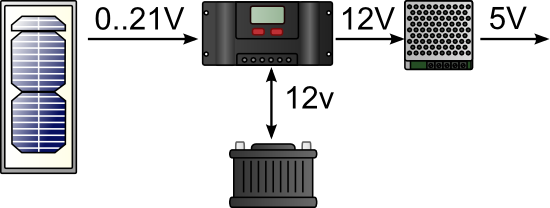
The power supply part
The Yoctopuce part
We decided to use a Yocto-Volt to monitor the tension of the battery, a Yocto-Temperature to monitor the temperature inside the case, and a Yocto-Relay to pilot a small fan: no doubt that it's going to be very hot inside the case when it's in full sun.
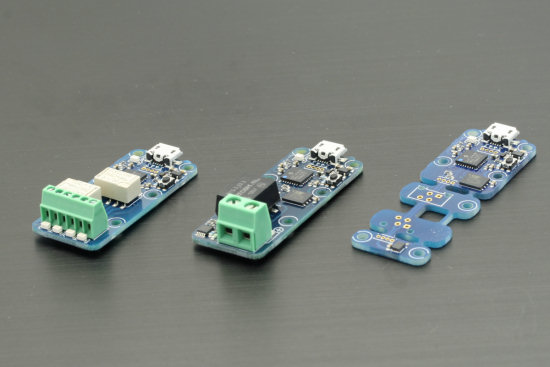
A Yocto-Relay, a Yocto-Volt, and a Yocto-Temperature
The control part
We have the power supply, we have the modules, we need to find a way to control these modules: we selected the brand new MK805. It is the big brother of the MK802 that we had the opportunity to test under Linux. The main difference resides in a Wifi board of a better quality than in the MK802, and in an external antenna which can be moved away.
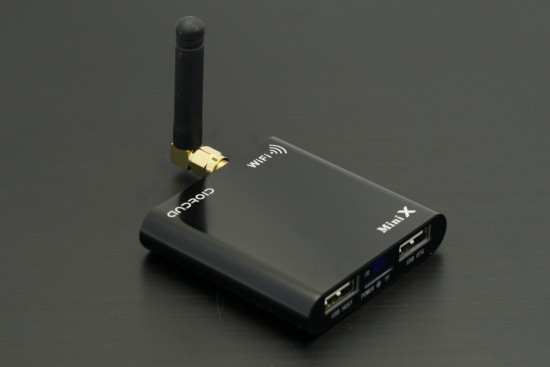
The MK805
The MK805 functions perfectly with the same Linux image as the MK802. The idea is to run it under Linux with a Python script which:
1- Retrieves the temperature in the case and the battery tension and posts the values on the Yoctopuce web site
2- Turns on the fan when it's too hot.
The case
We selected one of these storage cases equipped with a lid, but we use it upside down: the lid serves as a base and the case itself is used as a lid, so that the rain has little risk of going inside, and all the components are easily accessible when the "lid" is open.
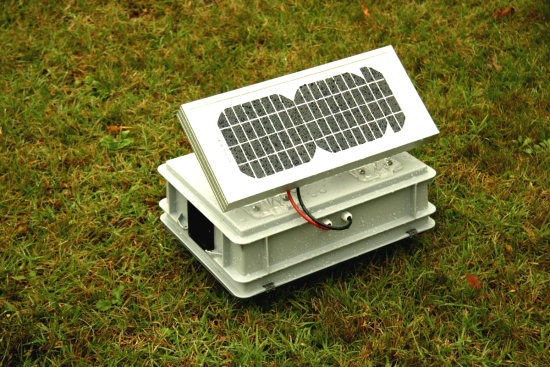
The solar experiment: notice that the rain starts as soon as we take it out :-(
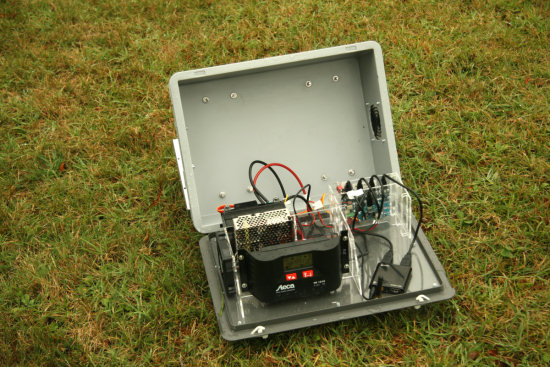
The inside of the case
First trials
The first trials are not very encouraging:
Without any load, the DC/DC converter consumes 88mA under 12 volts, it's already 1W used to do nothing.
If we connect the MK805, the consumption goes up to 300mA, and if we finally add the modules, the consumption reaches 450 mA, still at 12V, which equals 5.4W.
First observation: We consume more that the solar panel can provide when it's in full sun. Second observation: the battery being able to provide 35Wh, the installation can function only 6.5 hours on the battery, so not even a whole night.
We could increase the size of the solar panel and of the battery until they are able to provide enough energy, but the size of the whole experiment risks to become unreasonable pretty soon. We absolutely need to find a way to decrease power consumption.
First optimization
Thinking about it, we don't have to retrieve the measures all the time, a measure every 5 minutes is quite enough. We should find a way to switch the installation on every 5 minutes, retrieve the measures, and switch it off afterwards.
To do this, we use a trick which takes into account the fact that a Yoctopuce module doesn't necessarily need a USB link: it works as long as it has a power supply. We install a Yocto-Relay on the 5V power supply of the MK805 and of the modules, so that the relay can cut their power supply when it is activated.
This Yocto-Relay is controlled by the MK805, but powered directly from the DC/DC regulator, which means that it always has a power supply and therefore can always work, independently of the state of the MK805.
The idea is to program the MK805 so that it packs in by sending the PULSE command to the Yocto-Relay. This command activates the relay for a given time, which cuts the power supply of the MK805 and of the other modules. When the given time is elapsed, the relay deactivates itself on its own, thus reestablishing the power supply of the MK805 and of the other modules.
This rather drastic technique is going to make purists scream: it is possible that the OS of the MK805 won't like this treatment, but it's worth trying.
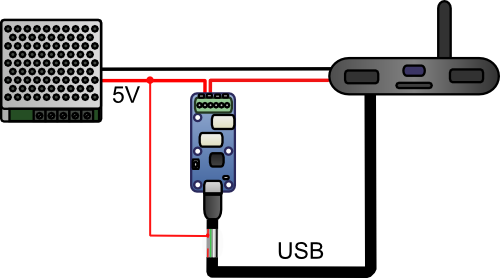
Using a Yocto-Relay to cut the power supply of the MK805 and reestablish it after a given time lapse
The price to pay is the relay consumption when it is activated. In use, we see that the DC/DC converter consumes 125 mA when the installation is in standby. Three times less than when it is active.
Appraisal after working for a few days
Here is a real time graph of the temperature in the case and of the battery tension.
The MK805 behaves remarkably better than the MK802. The Wifi range, although better than in the MK802, is not fantastic. More important, the MK805 can recover the Wifi link when it has lost it, which wasn't the case for the MK802.
In the opposite, on the electrical optimization side, there is still work to do to obtain an installation able to stay on 24/7. The issue doesn't come from the Yoctopuce modules which don't consume much, but from the controlling equipment:
- The DC/DC converter clearly consumes too much
- The solar panel is on the small side
- We noticed that the brand new battery, sold for 3Ah, provides only 1.6.
At the present time, the installation barely works in full sun and stops after a few hours as soon as night or rain comes :-(
But we won't stop here: we have planed some improvements. We'll keep you posted on the evolutions of the solar case on its dedicated page.


